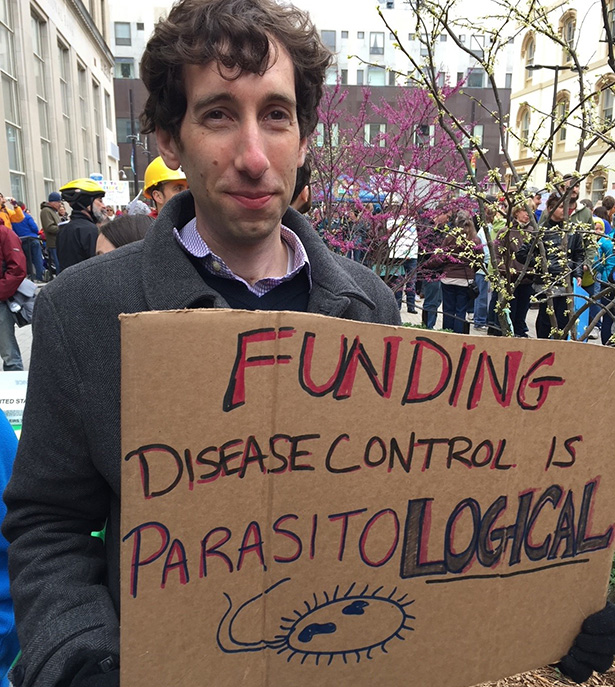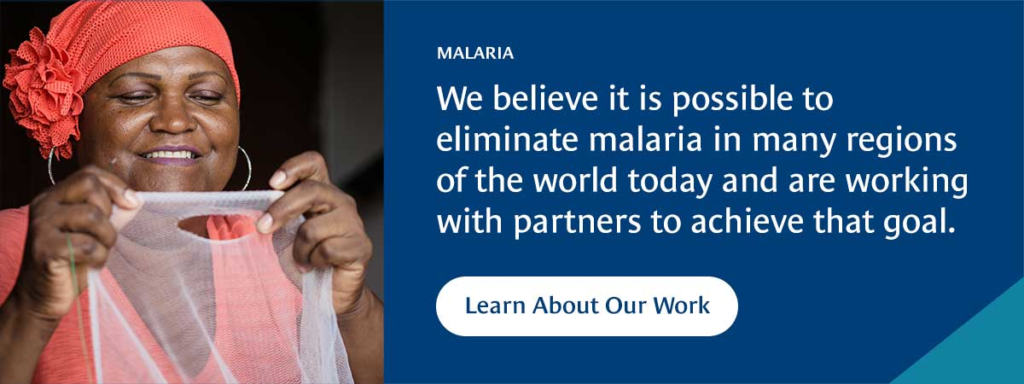Malaria was one of CHAI’s earliest program areas — launching in 2007 — and Justin Cohen has been around to see nearly everything. After working as a technical advisor for several years, Justin became director of the malaria program in 2013. Now as the program vice president, he has served as not only a constant, but truly a change agent both at CHAI and throughout the global malaria space.
In the past 10 years with Justin at the helm, CHAI’s malaria program has significantly expanded. Today, CHAI supports about 25 countries in their malaria-fighting activities and has expanded the approach into neglected tropical diseases (NTDs). However, the best measure of the malaria program’s success is not its growth, but where it has worked itself out of a job, including recent transitions out of Botswana and South Africa following completion of efforts to strengthen national malaria surveillance and data use.
Despite substantial progress in the modern era of malaria control, great challenges lie on the road ahead. Climate change is altering vector dynamics, funding is not keeping up with the cost of commodities and population growth, and mosquito and drug resistance complicates strategies against the disease. We caught up with Justin to hear a little bit about his decade leading CHAI’s malaria program and his thoughts on future progress.

Q: The global malaria landscape has changed drastically throughout history, but particularly in the past two decades. What were some of the most impactful gains during that time?
Justin Cohen: The single biggest change over the past two decades has been the increase in donor funding available to fight malaria, particularly through the Global Fund to Fight AIDs, Tuberculosis, and Malaria and the United States President’s Malaria Initiative. In 2003, donors contributed less than US$200 million annually to fight malaria. This year it’s over US$2 billion. Government malaria programs in endemic countries are using those funds to distribute insecticide-treated bed nets; give children prophylaxis before the start of the malaria season; equip health facilities; pay community health workers to test and treat for malaria; and many other life-saving activities that have enabled truly historic gains against the disease. Across sub-Saharan Africa, on average around one out of every three people were infected with malaria parasites in 2000, whereas today that rate has been cut in half.
Q: You’ve been leading the CHAI Malaria program for 10 years now. How has the program changed over the past decade to make meaningful progress against malaria in the current global context?
JC: CHAI has always looked to fill gaps in the global malaria landscape to catalyze action in neglected areas. When I started as CHAI’s malaria director, we were particularly focused on driving progress towards malaria elimination in certain regions of the world, including the Mekong Subregion of Southeast Asia and Central America. At the time, there wasn’t much up-to-date guidance for countries to approach elimination in a modern context, and we saw important opportunities to update historical approaches with modern digital surveillance systems and mobile reporting. We’ve helped more than ten countries roll out fit-for-purpose surveillance systems that collect geographically-located data on individual malaria patients rather than just aggregate information, enabling far more precision in designing effective elimination programs. As these elimination systems have improved, we are shifting our efforts towards supporting similarly rigorous disease surveillance for data collection, integration, analysis, and response in the world’s highest burden countries, which have just as much a need for accurate surveillance data to allow them to design smart, effective programs.
Q: What do you anticipate the next 10 years might look like for malaria progress as a whole? What persistent or new challenges are most threatening today, and are we prepared to address them?
JC: We have an overflowing toolbox of effective tools for preventing and treating malaria, including several different next-generation insecticide-treated bed nets, chemoprevention, residual spraying of insecticides, a variety of good drugs, point of care rapid diagnostic tests, and now even some modestly effective vaccines. Beyond those, we have strategies like preventing mosquitoes from entering houses by screening windows and doors, almost never deployed at scale against malaria—but that we know could reduce transmission.
The challenge for the next decade is not that we lack tools, but that government malaria programs don’t yet have the resources and systems required to buy and distribute enough of them to the people who need them. The countries with the most malaria in the world also have the fastest population growth. This means every year there are more people who need to be protected and treated. At the same time, we need to switch to newer, more effective—and more expensive—tools because mosquitoes and parasites are developing resistance to our old ones. Getting more expensive products to more and more people will only be possible if malaria financing grows apace, and right now it isn’t. Malaria funding grew by an annual average of 15 percent from 2000 to 2009. But since then, it has grown by less than 2 percent a year—not enough to keep up with our needs. That means we have to get a lot cleverer about how we spend our increasingly constrained budgets. We need to tailor our interventions based on high quality surveillance, target our tools to the places where they’ll have greatest impact, and build more efficient health systems and delivery mechanisms that can keep people protected and treated sustainably at low cost. As a community, we’ve begun taking important steps in this direction, but we have a long way to go.
“Governments are the entities that must be responsible for the health of the populace. Our job is to help them succeed, not build parallel systems that compete.”
Q: You have written over 50 scientific publications related to malaria control and elimination. Can you share briefly share what you’ve learned over the years and how you’ve integrated it into your approach at CHAI?
JC: I’ve learned so much, and it’s the joy of this job that I’m still learning new things almost every day. We’re currently supporting governments in around 25 countries, and every program faces unique challenges; we’ve contributed to some exciting successes that have given me clues about what works, and we’ve had plenty of failures that have been at least as instructive in teaching me what doesn’t. For me, a fundamental lesson is, first, that governments are the entities that must be responsible for the health of the populace, and our job should be to help them succeed, not to build parallel systems that compete with them; and second, those governmental programs must be well resourced: when malaria budgets increase, we make huge strides against the disease, and when funding declines, we can lose them.
Q: Tackling malaria is daunting at all levels, from global systems all the way down to mosquito larvae. What keeps you hopeful and motivated on the day-to-day?
JC: Malaria has been a scourge for all of humankind. That means people and communities around the world have been devising ways of preventing it and treating it for likely all our history. Some people found that chewing the bark of certain trees could cure the sickness it causes; others identified specific mosquito species that spread it; some were able to decode its genetic sequences. Generations of clever humans have contributed entomology, immunology, sociology, financial engineering, manufacturing, and so many other small but essential contributions. We have built this cathedral of knowledge to understand these parasites, the diseases they cause, and how to stop them. It’s inspiring and humbling to contribute to a little chapter of that broad arc of human ingenuity and resiliency that is slowly but inexorably making the world a healthier place to live.






